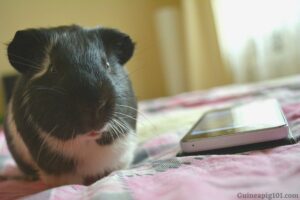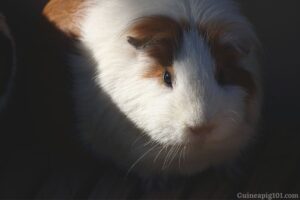Dewlap in guinea pigs
Female guinea pig of 6 years old with left double chin (Pt 1 of 2).
An extra pouch of skin that hangs below the guinea pig’s neck or jaw is known as a dewlap in this species.
The dewlap is typically developed in both male and female guinea pigs by the time they are 2 or 3 years old.
Do male guinea pigs have dewlaps?
The dewlaps on male guinea pig’s ears can be seen, but they are much less noticeable than those on female guinea pig’s ears.
A guinea pig with dewlaps is considered to have high estrogen levels when compared to other male guinea pigs, which is why they are used in performance.
In the case of guinea pigs, if they are neutered before they reach puberty, this results in high estrogen levels in their bodies.
After puberty, guinea pigs that have been neutered are more likely to have smaller dewlaps and to produce less estrogen than those that have not been neutered.
Does dewlap indicates obesity
Weight-related double chins will be more prominent in the overweight guinea pig than in the normal-weighted one. That holds true for both male and female guinea pigs who are overweight.
However, even though overweight guinea pigs have larger dewlaps, the presence of dewlaps does not necessarily indicate that the animal is overweight.
If you compare guinea pigs of different breeds, unsprayed females, and guinea pigs with hanging skin, you will find that they are more likely to have dewlaps than other guinea pigs, regardless of whether they are fat or not.
Veterinary advice on weight loss diets can be obtained from your veterinarian if you suspect that your guinea pig has a redundant dewlap as a result of being overweight.
Guinea pig pulling their hair out
Pulling of hairs by guinea pigs can be strange for most of the owners for the first time, but this is completely common. During the female guinea pig’s nesting stage, they will pull their hair out.
If your guinea pig has been spayed, your guinea pig can go through a false pregnancy, and create the nesting habits as an expecting, an unspayed female guinea pig.
That is because of the stress, or sexual stimulation that affects the female ovulates guinea pigs, convincing them that they are pregnant.
However, take your guinea pig to a veterinary surgeon immediately. If you find your guinea pig is having a severe injury to the skin bottom and pull their hair out from the dewlap.
Common health problems related to double chin
There are two major issues that must be addressed in the case of guinea pigs with prominent dewlap:
Unable to groom
If your guinea pig is overweight and has a large dewlap, they may have difficulty eating and grooming themselves.
Because they are not capable of grooming themselves, guinea pigs may have leftover or uneaten food lodged between the folds of loose skin on their dewlap when they are not capable of grooming themselves. Additionally, it has the potential to breed bacteria and spread infection.
It may be necessary to put your guinea pig on a diet if you discover that their large dewlap is the result of their being overweight. In severe cases, your veterinary surgeon may recommend that you undergo surgery to reduce the amount of dewlap on your face.
Moreover, grooming your Guinea pig every day can help you avoid any problems if your guinea pig has an excessively large dewlap, which may be due to their breed or the fact that they have reached sexual maturity.
In order to keep your guinea pig from becoming matted and dirty during the shedding season, you should clean the dewlap on a regular basis. However, surgical removal of the dewlap may still be required in severe cases.
Wet dewlap
The condition known as moist dermatitis is also known as wet dewlap. It is a painful skin condition that affects guinea pigs.
If you look closely at the dewlap of an older guinea pig, you will notice that it looks like a swollen area within body tissue. It is common for moist dermatitis and loose skin dermatitis to take the form of a dewlap when they first appear.
Causes of wet dewlap
A dewlap is a skin dropping that can be found under your guinea pig’s chin and is not harmful.
When the dewlap is constantly wet and not allowed to dry completely, the guinea pigs can become inflamed and irritated. Over time, the skin of dewlaps can become infected with bacteria.
A dewlap can become permanently soaked for a variety of reasons, including the following:
- Unhygienic living conditions.
- Leaking of a water bottle.
- Being overweight and having a big dewlap.
- Dental problems that cause hypersalivation or drooling.
- Not drinking from the bottle but from a bowl can cause a dewlap to become wet every time your guinea pig drinks.
That can cause your guinea pig’s chin and dewlap to become wet. If saliva is left on the skin for an extended period of time, it has the potential to cause corrosion. It can also open the pores of the skin, causing irritation.
Signs of wet dewlap
Wet dermatitides, such as a dewlap, are characterized by the hair of guinea pigs coming out of the infected area, which is one of the most noticeable symptoms. The skin that has been exposed may appear red, sore, and raw.
It is possible for the skin of your guinea pig to become infected and turn green. The flies will be attracted to the sores on the skin, and they will lay their eggs on the infected area of the skin. If the situation continues in this manner, you will notice maggots crawling on a dewlap, which is a bad sign.
Treatment of wet dewlap
When you deal with your guinea pig’s situation in its early stages, treatment can be completed relatively quickly. It is likely that the veterinarian will trim or shave the hair from the dewlap in order to improve the effectiveness of drying your guinea pig’s skin.
In addition, the owner may apply antibiotic powder to the infected skin in order to keep the area from becoming infected. In addition, the veterinary surgeon will provide you with additional instructions on how to prevent excessive wetness on the dewlap of your guinea pig.
When the situation worsens, it may become more difficult to treat them effectively. Veterinary specialists can prescribe antibiotics for your guinea pig in order to treat the infection. Many antibiotics are not safe for your guinea pig to be given in large doses.
Prevent wet dewlap in guinea pigs
The most effective method of preventing wet dermatitis on a dewlap is to keep the area as dry as possible. Here are a few pointers:
- You should trim the dewlap hair on your guinea pig and clean the area on a regular basis to allow it to dry quickly.
- By providing your guinea pig with toys to chew on and an unlimited supply of hay, you can help to prevent dental problems in the future.
- Remove any wet or solid bedding from your guinea pig’s enclosure and clean the area around it.
- Instead of bowls, use those bottles that don’t have any leakage problems..
If your guinea pig has a dewlap, you will need to groom them on a regular basis. Keep the dewlap dry in order to prevent infection and irritation.
It is possible to put an overweight guinea pig who also has a dewlap on a diet in order to prevent grooming issues from occurring.
Conclusion:
Except in a few male guinea pigs, dewlap (double chin) is fairly common in guinea pigs. When guinea pigs are spayed at a young age, the dewlap is no longer visible on their backs.
It is also not necessary that a guinea pig is overweight simply because of a double chin. Male guinea pigs are also equipped with a dewlap, which is almost inconspicuous..
A large dewlap on an overweight guinea pig does not necessarily imply that the animal is obese. Additionally, you should contact your veterinarian if you notice that your guinea pig has excessive dewlaps as a result of their obesity.
In the course of their nesting process, guinea pigs remove their fur from the dewlap. Stress or sexual stimulation could be the cause of this ailment. Double chin is associated with two types of common health problems: wet dewlap and inability to groom one’s teeth.
It is possible that a water bottle has leaked, that you have drunk from a bowl, that you have lived in unsanitary conditions, or that you have a large dewlap because you are overweight or have dental problems.
A powdered antibiotic can aid in the healing of an infected area. In order to prevent wet dewlap in guinea pigs, you can trim their hairs and clean the area around their enclosure. You can also use bottles and provide them with toys or hay.




